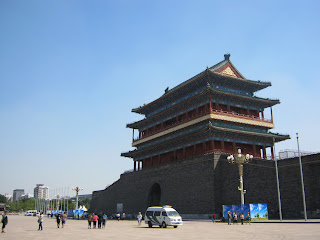Saturday was the day I
finally was able to see Tiān'ānmén Guǎngchǎng, (天安门广场;Heavenly Peace Gate Square)
one of the more popular tourist attractions in Beijing and China in
general. Along with my British friends
and a few Koreans from their class, we took the Line 1 subway from the station
outside our university, we reached the Tian’anmen East Station (天安门东站;Tiān'ānmén dōng zhàn) after
10 stops. Walking out of the station,
the first view I received was the East wing of the Gate of Heavenly Peace (and,
of course, Chairmen Mao’s mug). The
square itself is a relatively new addition (judging by the more
Communist/brutalistic design of the National Museum, the Great Hall of the
People, Mao’s Mausoleum and the Monument to the People’s Heroes), with the
aforementioned structures having been added in the late 1950s. Tian’anmen itself, though, was built in 1420
during the Ming Dynasty (明朝;Ming Chao) and has been rebuilt numerous times due
to fires, bombardment and other reasons.
The name of the gate was also changed over the years, as it was at first
called the Gate of Accepting Heavenly Mandate, or Chengtianmen (承天门). Following the establishment of the People’s
Republic of China on October 1st, 1949, the square itself underwent great
changes. Three structures went up in the
square from 1958 to 1959 in preparation for the 10th Anniversary of the
founding of the PRC: the Great Hall of the People to the West,
where the
National Congress meets, the National Museum of China (then called the
Revolutionary History Museum) to the East
and the large obelisk that is the
Monument to the People’s Heroes in the center of the square. The last building in the square, situated
south of the Monument to the People’s Heroes is the Chairman Mao Memorial Hall,
which not only commemorates the Chairman but also serves as his Mausoleum
(although I have heard the lines to get into the Mausoleum are usually very
long, when we came there it seemed to be closed or no one was there).
Following the look at Tian’anmen,
we went to Qianmen (前门;Front Gate), a structure that was built in 1412
during the Ming Dynasty as the entrance and defense for the inner city of
Beijing.
The gate itself was an interesting structure, different from the other structures of the Imperial City in that it is gray instead of red.
Much like Tian’anmen, the structure has been destroyed and rebuilt numerous times, and even served as the quarters of the Beijing regiment of the Red Guards from 1949 to 1980. Another thing to note about Qianmen is that its central location in the modern layout of Beijing led to it serving as the starting point of all road systems in and leading out of Beijing (as noted by the monument below).
After spending a few minutes at Qianmen to rest and having a big lunch at a nearby KFC – which I’ll admit is much better than it is in the States – we took a walk East to Wángfǔjǐng Xiǎochī Jiē (王府井小吃街;Wangfujing Snack Street) to browse the bizarre delights that abound in the seemingly endless food stands in this cramped hutong. From live baby scorpions on sticks (cooked fresh when you order!) to cockroaches, centipedes, candied fruits and baby birds cooked whole,
the area seemed more like a place to go to take pictures than a place to actually purchase snacks -- save for the candied fruits, mind you. This is because most of the stalls served the same fare, namely: cooked scorpions, cockroaches, centipedes, that seemed to be more for show and less for eating. So, we browsed the crammed hutong and eventually found something seemingly edible:
an orange drink (seemed like flat soda) with a piece of dry ice in it, thus making it fizz and smoke. Returning to Erwai after a long day of sightseeing and adventures, all I wanted to do was return to my dormitory and take a long nap, which I thankfully did.
The gate itself was an interesting structure, different from the other structures of the Imperial City in that it is gray instead of red.
Much like Tian’anmen, the structure has been destroyed and rebuilt numerous times, and even served as the quarters of the Beijing regiment of the Red Guards from 1949 to 1980. Another thing to note about Qianmen is that its central location in the modern layout of Beijing led to it serving as the starting point of all road systems in and leading out of Beijing (as noted by the monument below).
After spending a few minutes at Qianmen to rest and having a big lunch at a nearby KFC – which I’ll admit is much better than it is in the States – we took a walk East to Wángfǔjǐng Xiǎochī Jiē (王府井小吃街;Wangfujing Snack Street) to browse the bizarre delights that abound in the seemingly endless food stands in this cramped hutong. From live baby scorpions on sticks (cooked fresh when you order!) to cockroaches, centipedes, candied fruits and baby birds cooked whole,
the area seemed more like a place to go to take pictures than a place to actually purchase snacks -- save for the candied fruits, mind you. This is because most of the stalls served the same fare, namely: cooked scorpions, cockroaches, centipedes, that seemed to be more for show and less for eating. So, we browsed the crammed hutong and eventually found something seemingly edible:
an orange drink (seemed like flat soda) with a piece of dry ice in it, thus making it fizz and smoke. Returning to Erwai after a long day of sightseeing and adventures, all I wanted to do was return to my dormitory and take a long nap, which I thankfully did.








No comments:
Post a Comment